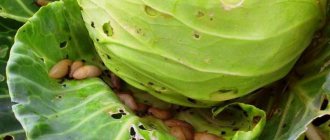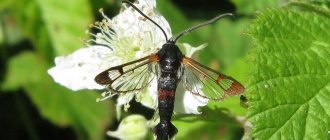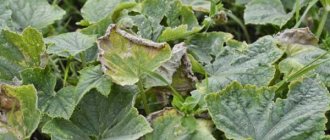Mole rat
In many ways it is similar to a mole, although it is larger in size, but the marks it leaves behind are about the same.
The main difference is that mole rats are voracious rodents, and the fight against them can be painful and long. Mole rats are usually no more than 32 cm in length. They have very short legs and gray fur. The tail is not visible, as it is too small, the eyes are reduced and hidden under the skin.
The widest part of a mole rat's body is its head. If you look at the animal from above, it resembles a shovel. The mole rat's front teeth are long and protrude.
This pest especially loves potatoes and carrots; it affects garlic and beets, onions and bulbous flowers. It can also damage other plants, such as corn or beans.
The fight against mole rats, due to their underground lifestyle, is not always effective, but is still possible. Just remember that there is a giant mole rat listed in the Red Book.
Usually, when the entire garden is in holes, the summer resident is not particularly concerned about who did it, just to exterminate the pest. The giant mole rat is distributed mainly in sandy and clayey soils near water bodies.
They can be found in the Caucasus, in Dagestan, near the Terek, Sulak and Kuma rivers. It may turn out that just such a rare animal lives on your site.
Giant mole rat
Common mole rat
Mole rat minks
There are several ways to get rid of the pest.
The first way is to set traps. This method is not very effective, because mole rats are smart and cunning. It is best to get mole traps. When fighting a mole rat, you can be cunning.
Animals do not like open areas and wind, so you can dig up their hole and make another smaller one next door. Place a trap in the hole and cover it with something. When choosing from two options, the mole rat will, of course, choose the more protected one and will most likely fall into a trap.
The second way is to flood the holes. The mole rat is quite helpless against water. But if your soil is sandy and absorbs moisture well, then most likely this method of control will not suit you.
The third way is to use poisons and chemicals. But it may also not work. If there is enough food for a mole rat in your area, then it will not even look in the direction of the poison.
The fourth method and one of the most effective is noise and ultrasound. Mole rats hate noise. Therefore, installing noise repellers will not be superfluous. One of the surest methods is a vibration-sound repeller.
Ground rat in the garden
It is not difficult to guess that with a large number of pests in one area, the entire crop may suffer. The rat stuffs small potatoes into the pantry, and gnaws large ones on the spot. The same thing happens with carrots and beets. In addition to stealing the crop and damaging it, the earth rat damages all vegetation with its moves. They are located close to the surface of the earth. In the process of digging, the rat touches roots and stems. They end up on the soil surface, dry out over time, and the plant dies. In Holland, the ground rat is considered a dangerous pest of tulips. There is nothing in the garden or flower beds that a rodent would disdain. Even weeds are used.
When harvesting grain crops, mounds on the surface of the ground make harvesting difficult. In addition, the earth rat covers the fallen stems with earth. The pest gnaws the bark of young trees. After a feast of several individuals, the tree dries up. It is difficult to overestimate the damage caused by the earth rat. With strong reproduction, the pest can destroy literally everything. Considering the great fertility of the earthen rat, the reaction to the presence of rodents in the garden should be immediate.
Vole
Looks like an ordinary mouse. Body length is no more than 13 cm. The color is brown, and gray on the tummy. Unlike the shrew, the vole will feed on your crop.
She likes roots, shoots, leaves and sometimes even seeds of some plants (for example, beans). It is even more prolific than the shrew - the field mouse is capable of reproducing offspring up to 7 times per season, 5 and sometimes 12 babies each.
In winter, voles are protected by a layer of fallen snow, so pests may simply not survive snowless winters. In winter, they can harm raspberry bushes and gardens.
Below is a photo of field mouse burrows. Pests usually live in groups and dig branched, complex tunnels. But this happens at a shallow depth - from 15 to 35 cm. Regular weed removal and timely harvesting will help prevent the appearance of voles on your site.
But alas, even taking all the precautions cannot guarantee that you won’t get a vole
So, what to do if field mice are already infested on your property?
The first way is to get a good, not lazy cat. Of course, if you take a kitten, things will not go the fastest, but this method can scare away voles for a long time and protect your area.
It would not be the wisest decision to use traps, since they are effective in the presence of only a few pests, and the number of voles tends to increase quickly.
The second method is poisoned baits and toxic substances. For example, you can make lumps of dry plaster and flour or other treats. Voles love to drink after eating, and gypsum congealed in the stomach will lead to immediate death. You can flood the holes, treat them with poisonous gases, or use an acute poison, after consuming which the animal will die.
Voles are smart, so if you choose a poison, it is better to choose one that the rodent needs to eat once than substances with a cumulative effect.
The third method is smells and noises. A variety of ultrasonic repellers work effectively. Also, voles cannot tolerate the smells of elderberries and nuts, and they really do not like the aromas of essential oils. Therefore, you can put walnut leaves, elderberry, even garlic or a piece of fabric soaked in essential oil or, for example, kerosene in their hole.
Popular Breeding bumblebees
The fourth method is ammonium nitrate solution, 3%. It needs to be poured into the hole (about 1 cup) and trampled on top. Ammonia is harmful to voles.
Division by action
The poison for mice and rats acts instantly or with a delay of 3-7 days. In the first case, the drug contains fast-acting poisons that cause severe food poisoning or swelling of the lungs. The death of a rodent occurs within 3 hours when a minimal amount of poison enters the body. The pest dies from severe intoxication or suffocation.
The poison from rats and mice of the second group acts gradually. The composition includes substances that disrupt blood circulation and cause internal hemorrhage. The negative aspect of these drugs is the possibility of developing resistance in rodents. On the positive side, a mouse or rat eats the poison without knowing anything. Whereas the sudden death of relatives is very alarming. Rodents can sense something is wrong and avoid the potent poison.
The most powerful rat poison with an immediate effect was produced on the basis of strychnine, thallium salts, lead, phosphorus, and arsenic. Phosphorus damages bone tissue, arsenic affects the nervous system, and other components cause severe poisoning. Subsequently, experts announced the severe toxicity of the drugs. Poisons for mice and rats were discontinued and banned from use.
Preparations based on zoocoumarins have become widespread for home use. The new generation of anticoagulants kill mice within 3 days after receiving the first dose of poison, and rats within 1-2 weeks.
Rodenticides are all chemical agents used to control rodents. Some poison pests when they enter the stomach, others (fumigants) act by inhalation. Fumigation products produce a gas that is heavier than air. It spreads along the ground and penetrates rodent burrows.
Principles of action of toxic substances:
- Zinc phosphide produces a toxic gas (phosphine) that can poison rodents.
- Chlorine and other asphyxiating gases cause acute asphyxia.
- Krysid disrupts breathing processes.
- Phosphine disrupts metabolism and paralyzes the nervous system, producing an acute and rapid toxic effect.
Anticoagulants reduce blood clotting, causing increased bleeding in the animal, leading to their death.
Traps
A mousetrap is the first thing that comes to mind when it comes to exterminating rodents. Modern manufacturers of traps for rodent pests can present many models.
The most effective and humane device is considered to be an ultrasonic repeller. The only drawback is the high cost.
All traps are divided into two types:
- fatal (all that remains is to remove the rodent carcass and throw it away from the house);
- humane live traps (a rat, falling into a trap, remains safe and sound).
The humaneness of the latest traps is called into question, since you will have to kill the animal yourself. By releasing it into the wild (even far from living quarters), you will not protect your house and garden from further attacks.
Basic trap mechanisms:
- Electric trap. Battery operated. Installed in a living room, barn or garden. The animal dies from an electrical discharge. The indicator indicates the presence of a victim inside. The disadvantage is the rather high cost.
- Spring trap. A classic device for catching mice. The trigger mechanism pinches the rodent, breaking its spine. Most often this leads to the rapid death of the victim. Disadvantage: The trap often kills birds and injures small pets.
- Live trap. It is a box with bait inside. After touching the food, the door closes behind the rat.
Description and features of the rodent
The ground (or water) rat is a large vole that prefers to settle near water bodies in areas rich in food. At the same time, it can live far from water - in meadows, vegetable gardens, fields and gardens.
The earth rat has a rounded body, a shortened muzzle with small ears, soft fur, and short legs. The tail is covered with sparse hairs and ends in a small brush about 0.5 cm long. The eyes are smaller than those of a rat. The front teeth (incisors) are brown-yellow in color. The fur of this animal is evenly colored dark brown, sometimes almost black.
Lifestyle
Ground rats are predominantly nocturnal, during which they spend most of their time in their burrows, coming to the surface only in search of food. This happens in the evening or at night. Moreover, the rats do not move far from the hole. Active at night, these rodents rarely catch the eye of gardeners. The presence of pests is indicated by eaten above-ground parts of plants and their sudden death.
Rat passages, up to 5 cm in diameter, lie at a depth of 10 to 80 cm. They are distinguished by a complex system of branches and considerable length. The underground labyrinth connects the nest, storage areas and numerous exits to the surface. The rat rests in the nest and breeds offspring.
In places where burrows are made, pests destroy the root system of any plants, be they bulbs, root crops, weeds, fruit trees or shrubs. Ground rats, also called water voles, can swim well and climb trees. In winter they eat what they stored in summer.
Diet
Proliferating earth rats in the countryside are a real disaster for the owners, since by digging holes, they destroy all the plants in their path. Loves root vegetables and flower bulbs. Eats roots and green parts of plants. If you come across young trees or bushes along the way, then earth rats can cause their death. They gnaw the roots, eat the bark, after which the plant becomes sick and may die. Rats prefer apple trees, bird cherry and willow.
In addition to plant foods, earth rats eat insects, bird eggs, chicks, and even their close relatives - small field mice. Living near bodies of water, the ground rat swims well and dives well. Underwater it catches aquatic plants, small fish, mollusks, crayfish, insects and their larvae.
Rodents eat not only the roots and tubers of cultivated plants. Weeds are also part of their diet.
Habitat
The ground rat prefers to settle near bodies of water. They are attracted to wet lowlands rich in food along the banks of reservoirs, areas near swamps and damp meadows. During river floods, rodents move to drier, more suitable places for life.
Earth rats leave their previous habitats due to natural disasters such as floods, droughts, early frosts or simply lack of food. When such conditions occur, rodents move to fields, gardens and orchards in search of food, causing significant damage to the crop.
Habitat and lifestyle
The water vole (also called the water rat) is a fairly large rodent, similar in appearance to a rat, but thicker and with a short tail.
- The body length of an adult animal reaches 15-22 centimeters,
- tail - approximately 8-12 centimeters, about half the length of the body.
- The fur of the animal is noteworthy - dark in color and very thick.
It lives in damp and swampy places near lakes, rivers, and ponds. In the warm season, it lives in burrows near water; by the end of the season, it moves to dry places closer to food sources.
If you carefully look at the photo of a water rat, it immediately becomes clear that it looks more like a hamster than its gray relative.
Quite often, having discovered tunnels and damaged plants, property owners come to the conclusion that they have moles. In fact, it is very simple to distinguish them - moles dig up heaps of earth, and a water rat can be detected by uprooted plants.
Water voles (rats) on the site can cause crop loss
As soon as you see a dead perennial bush with damaged roots undermining, think about it: a water vole is somewhere nearby.
Water rats are so named because they live near water and can swim. You can meet them near large streams and rivers, reservoirs and lakes with weakly flowing or standing water and swamps. But these animals are not limited to the aquatic environment. They love to enter areas adjacent to water, including fields, garden plots and vegetable gardens.
Rats live in burrows dug underground, characterized by considerable length and a complex system of branches. Near the entrance to them you can see heaps of soil thrown to the surface.
The offspring of the water rat are born in warm spring and summer. Pregnancy in females lasts only 20 days. During the season, each female brings from 4 to 6 litters, which can contain from 6 to 14 babies. Rats leave their burrows as soon as their weight reaches half the weight of adults. It’s not hard to guess what the water rat eats.
- roots;
- young fruit plantings;
- berry bushes.
Young trees and shrubs attract rats with their bark and roots, which they are not averse to eating. In winter, they feed on what they stored in summer.
Water voles live in the northern part of Eurasia. The southern border of the habitat runs along the northern coast of the Mediterranean Sea, Asia Minor and Western Asia, the northern regions of Mongolia and China. In Russia it lives in the non-chernozem zone, Stavropol Territory, Lower Volga region and Siberia.
How to get rid of water rats in the garden
Prevention, as we know, is the best medicine. If a water rat appears, this rule also applies.
If there is a pond on your property or your neighbors already have these rodents, you can try to at least minimize the likelihood of them coming onto your territory. To do this, at a minimum, you should keep the area clean and tidy - mow the banks of reservoirs, small bushes and weeds along the fences, do not store plant debris in piles in inconspicuous corners or leave it in the aisles, remove garbage in a timely manner, dig up the soil deeply, and promptly remove crops and fallen wood. , protect tree trunks for the winter, periodically compact the snow in the garden.
If water rats have already taken a fancy to your garden, you will have to fight them “on the spot.” And there are several ways to do this.
In nature, this small rodent has many enemies - from large birds (owls, crows, seagulls, harriers, etc.) to foxes and ferrets. Therefore, if you have cats or dogs living on your property, usually their smell is enough to scare away a water rat. If your pets are real active hunters, then you have nothing to worry about at all; they will save you from voles.
If you don’t have domestic predators in your dacha, you’ll have to think about other methods of fighting water rats. You should not use toxic chemicals for this purpose - firstly, scattered around the site, they can dissolve and harm the soil and plants, and secondly, they can poison pets or representatives of “useful” fauna.
To guarantee the extermination of the water vole, arc and spring traps, box traps with bait, loops, and catch buckets are successfully used. These traps are installed at the entrances to discovered rodent burrows or simply in secluded places on the site (shrubs, thickets of weeds or near-water vegetation, etc.).
In large areas, specialized ultrasonic repellers can be used. In small areas, where there are only 3-4 units of fruit trees, before planting the seedlings in the planting hole, it is recommended to place a metal fine mesh so that in the future rodents do not get to the roots.
Popular How to get rid of aphids on cherries
Some advise using traditional methods against water rats - the animals do not like the smell of burning wool and smoke bombs, prickly spruce branches placed on the site, thickets of black elderberry, etc. But you need to understand that such measures will, rather, be temporary and deterrent, but will not help in any way to physically get rid of rodents for good.
If one water rat on a site does not cause much harm, then a whole colony of such rodents in the autumn-winter period is quite capable of causing significant damage to your plantings and harvests, and getting rid of an entire group of animals can be a difficult task. Therefore, it is worth making efforts to prevent the occurrence of such a situation, carefully monitor the order in the country and apply preventive measures to repel the water vole.
Ways to control water voles
- Tar
- Naphthalene
- Kerosene
- Calcium carbide
Soak pieces of fabric in the chosen solution and then bury them in the ground.
The royal hazel grouse flower helps in the fight against moles
In garden supply stores you can purchase mole traps of various designs. Catching a mole in such traps is not an easy task. First, you need to set a trap where the mole begins to dig. Secondly, the mole is very smart, he has a well-developed sense of smell, and he knows how to avoid traps.
For a trap to work, you must do the following:
- First, find the main passage.
- Dig a hole outwards from this passage.
- Make a hole 1 m from the hole in which to place the trap.
- The trap should be covered with earth.
Thus, a draft will appear in the mole’s hole, which the animal does not like. Soon the mole will come to repair the hole and fall into the trap. A properly placed trap can go off within 1 hour.
A dog is another reliable way to catch a mole. Having sensed the location of the animal, the dog begins to dig the ground, and itself gets the mole.
Some summer residents resort to the most brutal measures if they cannot remove the mole by humane means. Seeing a fresh mound of earth, they dig a hole and pour water from a watering hose under high pressure. The mole, sensing danger, climbs out.
The best way to protect a site is not to fight the mole, but to prevent it from entering the site. If you have seen a mole in neighboring areas of a mole’s hole, but have not yet found one in your own home, it’s time to start taking preventive measures. To do this, you can dig a fine metal mesh around the perimeter of the plot or garden to a depth of 0.5 m.
It is worth understanding that the mole does not hibernate, so it can appear on your site at any time.
Mouser cats (especially calico cats) are considered the best vole hunters
But what if your pet is not interested in hunting or you don’t have one at all?
One of the most popular and affordable options is to use pesticides against voles, and kill others along with these rodents. Manufacturers usually produce universal rodenticides. They are very easy to use: just buy them in a store and act strictly according to the instructions.
There is another option for using chemicals. In the spring, you can place cotton wool or dry grass treated with poison near the holes. The voles drag it into their homes to furnish the “interior,” while the poisoned dust falls on the fur of the pests, after which it is licked off by them.
Prevention against water rats
The described means will help you choose the appropriate means, suitable in each specific case for combating water rats in your summer cottage. Pests are cunning and smart, so even effective methods sometimes turn out to be ineffective. It is best to carry out preventive work to prevent a problem from occurring than to try to find the right solution to solve it. For prevention you need:
- Always maintain cleanliness and order in the garden and summer cottage. Any thicket, mountain of garbage or branches is an excellent place for water rats. Exits from burrows are often created near them, which the owners do not notice.
- The perimeter of the area can be surrounded by a hedge based on thorny plants; rose hips are suitable.
- In open areas, it is more effective to use submersible ultrasonic repellers.
- It is recommended to treat paths, seedlings and trees with ash, which will become a danger for rodents and a fertilizer for plants.
- At the end of each season, it is necessary to remove root crops by cleaning the beds.
- The appearance of rodents can be minimized by choosing the right site, which will be further from fields, pastures, and plantations.
- Monitor the cleanliness inside the house and country buildings.
- Grow plants that repel rodents (mint, elderberry, castor bean).
If the site is located near rivers and ponds, owners need to be on alert to preserve their own crops and garden. When burrows are spotted, you need to act quickly, otherwise there will be a lot of damage and the animals will begin to multiply quickly. They can destroy not only fruits, but also roots, bushes, and trees.
In order not to think about how to get rid of a water rat, you need to take simple preventive measures against their appearance. The main thing is to remember that in a clean and uncluttered area, the risk of encountering traces of water voles is several times lower. This means that it is necessary in a timely manner:
- remove rotten grass;
- take out garbage;
- clean the shoreline of the reservoir nearby.
Reviews of pest control methods
The water vole is considered a massive pest of agricultural land - pastures, hayfields, gardens and fields, as well as gardens and summer cottages. Moreover, rats cause the most significant damage to cultivated plants in areas located in floodplains and adjacent to reservoirs.
The damage caused by rats is as follows:
- In grain fields, they make holes in the ground, pull the soil to the surface and cover the ripening grains with it, making harvesting difficult.
- Carrots, potatoes and beets are eaten in vegetable fields. Do not touch garlic, onions, or legumes.
- In gardens and forestry, they gnaw the bark on trees, causing them to dry out.
- Private owners in their summer cottages are spoiling the harvest of vegetables and fruits.
- They also visit warehouses where finished vegetable products are stored.
We suggest you familiarize yourself with: Garden pests living in the ground
But the harm caused by water rats to humans is not limited to this. They can infect people with pathogens of hemorrhagic fever, tularemia, plague, tick-borne encephalitis, and leptospirosis. Therefore, the fight against these animals is carried out not only for agricultural crops, but also for the sake of public health.
Smells against moles
Some methods of fighting moles are based on irritating their sense of smell. The bulbs of some plant species have a rather specific odor that is unpleasant to animals.
These include garlic, beans, imperial hazel grouse, hemp, daffodils, marigolds, and blueberries. That is, if your site is occupied by small diggers, then you need to plant the entire area with one of the selected plants. Why do we say the entire territory - because on many forums, summer residents note that animals simply avoided flower beds with daffodils or beds with legumes, but did not leave the area. If you have just purchased your dacha, perhaps planting the land with daffodils is not the worst idea; in other cases, this method does not work effectively. Other scents are also used:
- Kerosene, fuel oil, antifreeze. A cloth soaked in a kerosene solution is placed in a molehill and dropped in drops. The solution is prepared at the rate of 100 ml of kerosene per bucket of water. Fuel oil or antifreeze is simply applied to rags;
- Naphthalene. The powder is poured directly into the molehill and covered with earth;
- The area is irrigated with a solution based on castor oil. 200 ml of oil is poured into a bucket of water and 2 tbsp is added. spoons of any detergent, mix thoroughly and distribute throughout the area. It is best to do this after rain or watering;
- You can use strong-smelling herbs - wormwood or mint. Tufts of grass are distributed into molehills and change as they wither;
- Raw fish heads, rotten eggs or rotten fruits/vegetables are placed in molehills and buried. During rotting, the products will emit an unpleasant odor, which should repel moles.
The disadvantage of this method is obvious - foul-smelling rotting fish, the pungent smell of kerosene or antifreeze will scare away not only moles, but also people from the area. In addition, the method will be effective only if the active substance is regularly replaced as the pungent odor evaporates. Otherwise, the animals will quickly return. Yes, and smoking out the unfortunate moles using this method will take quite a long time and painfully.
There are ready-made biological products on sale, so-called “flavors”. These are small balls that need to be distributed throughout the area according to the instructions.
Folk recipes
Ground rats do not tolerate proximity to chamomile
Traditional recipes for killing rats are considered less effective, but safer for family members, pets and crops. The most effective include the following:
- Growing plants. The roots of black elderberry release cyanide into the soil, poisoning rats, coniferous plants with needles injure them, burdock sticks to the skin and interferes. It is also worth planting plants that have an unpleasant odor for pests: garlic, mint, hazel grouse, tansy, wormwood, chamomile, juniper;
- Smoking. You will need to burn mint, wormwood or old rubber before entering the holes. The latter can be left for several days after burning. A sharp, unpleasant stench will force mice to run away.
- Use of gasoline and kerosene. It is necessary to wet pieces of rags and place them in front of the holes; you can also pour a glass of fuel inside. They note that the method gives almost instant results, but it must be used carefully, since gasoline spoils the soil and groundwater.
We suggest you read: How to grow green beans in the country
Description of the pest
The water rat is a mammal of the hamster family. It looks like an ordinary rat, but differs from it in its more elongated body, covered with soft, smooth and silky fur. The water rat has a shorter snout than the common rat, topped with short ears, and shorter legs hidden in long fur.
The water vole or ground rat, as this animal is also called, is the largest vole; only the muskrat is larger in its family. However, the body sizes of these rats vary significantly depending not only on geographical areas, but also on the different territories included in these areas.
The water rat also differs from the muskrat in that its tail is not flat, but round in cross-section, thin and not completely naked, but covered with sparse hairs and ending in a kind of brush half a centimeter long. The water rat can also be distinguished by its smaller eyes and yellow-brown middle incisors.
Rats weigh from 120 to 330 g with a body length of 11 to 26 cm, with the tail accounting for half or even two-thirds of the length of the rat’s body. The coat consists of clearly demarcated thin but dense down and a rough awn. The coat color is uniform, dark brown with slight red or almost black. Doesn't depend on the change of seasons. The fur of the water rat, thick and long, is good enough to be used for sewing outerwear and women's hats.
Popular How to get rid of mole crickets and protect your summer cottage from its appearance
Rat
Rats are very smart. And also, like any rodent, they are dangerous because they are carriers of many diseases. In the countryside, you can most often find a gray rat. People call it pasyuk.
It is quite large, can reach 27 cm in size. Pasyuk is omnivorous and swims well. It is he who digs holes in vegetable gardens, not particularly deep, but branched.
The rat is prolific - per year it can give birth to 3 litters of up to 10 cubs each. This large pest will also fight a large enemy if there is no place left to run to. Pasyuk can even attack a person.
Due to the mole cricket's addiction to cabbage, it is also called cabbage.
The cabbage nests are shallow - only 10–15 cm from the surface. In them, the female takes care of her offspring. The nest has many branches and exits.
The female regulates the conditions inside for the best development of the larvae - she opens and closes the entrances, gnaws out the roots of plants so that the nest warms up better. So the root system of plants is sufficiently affected, which leads to their death.
The mole cricket can overwinter in the ground at a depth of up to 2 m, and can also overwinter in manure. Often it is with compost that it ends up in gardens.
Fighting mole crickets, like other pests, is not easy. Getting rid of cabbage weed needs to be approached comprehensively, focusing on its characteristics and habits. Let's look at some preventive and preventive measures.
The first method is loosening and digging. You should try to dig no less than 15 cm deep. This procedure needs to be done about 3 times throughout the entire season. This way you will find mole cricket nests and eggs in the soil.
The soil with eggs must be removed from the garden - poured into a bucket or other container. And if you come across an adult mole cricket, then it also needs to be destroyed - crushed or chopped.
The second way is to lure with manure. In the spring, you can spread heaps of compost around the garden - mole crickets will find this a good place for their nests. Check the piles periodically, and if you find eggs or an adult, destroy them.
For wintering, the mole cricket will also prefer compost. At the end of autumn, dig several holes in which to place manure. When frost sets in, destroy and scatter the manure from the holes. The mole cricket simply won’t have time to hide in the ground and will freeze.
If the mole cricket has already started and can simply destroy your garden until late autumn, then you can remove it as follows.
The first method is detergents. Water mixed with powder or laundry soap and poured into the holes of the cabbage will either kill it or force it to crawl out. Then it can be destroyed manually.
The second way is poisons and chemicals. Preparations such as “Grom” or “Medvetox” can simply be poured into the minks, or they can be mixed with wheat porridge and placed in places that most need protection, or next to the minks. You can also use kerosene against cabbage weeds. The third method is traps. Kapustyankas are very fond of beer and honey. A jar with a small amount of beer (up to 100 g) should be buried at an angle in the ground, leaving the neck at the top.
The neck must be tied with gauze. The mole cricket will gnaw through the fabric and fall into the jar, and it will no longer be able to get out of there. Once the jar is full, the pests can be killed very easily.
If any of the above pests have appeared in your garden, prepare yourself for a long fight and be sure to first determine who exactly is digging the soil in your dacha.
Most likely, some of the methods will not suit you, but there will probably be one that will be life-saving. The best solution would be to use comprehensive control, using all possible methods.
The most dangerous pest of household plots and summer cottages is the ground rat or water vole. The animal belongs to the genus of mice, but has nothing in common with them. The way of life of an earth rat is somewhat similar to the way of life of a mole: it digs passages in the ground, so after its life activity small holes remain in the garden. In addition, the animal feels great in water, which complicates the fight against it.
This text describes the life functions of the earth rat, its harm to humans, as well as effective ways to get rid of this animal. If the presence of a water vole is detected on the site, then you need to immediately begin expelling it from the site. If you do everything correctly, following useful tips, then this procedure will not be so difficult.
Prevention of occurrence
Water rats have excellent fur coats and the ability to swim.
They usually settle along the banks of reservoirs, but in search of food they go deep into gardens and vegetable gardens, causing significant damage to plantings. These rodents live in burrows, digging entire passages underground. They damage the root system of fruit trees, and in winter they gnaw their bark, eat root crops, flowers, and other crops. But these pests usually don’t appear in the garden just like that. If the area is tidy and not cluttered, there are significantly fewer opportunities for rats to live there safely. When the ground is overgrown with small bushes, and there are garbage heaps everywhere, then all this serves as an ideal shelter for rat holes.
Before getting rid of rodents, you need to tidy up your area and keep it clean in the future. You can't litter it!
Later, in the fall, tree trunks should be tied with roofing felt and spruce branches. You can attach plastic bottles cut lengthwise around young trunks; on thaw days, you should trample the snow around the trees. You can get rid of rodents using special chemicals called rodenticides, which must be used in the fall or spring before the pests settle and multiply.
This section will be devoted to the so-called inhumane methods of struggle. The first of them is the familiar traps for rodents. You should buy a trap designed for fur-bearing animals. This method is suitable for cases where there are very few water voles.
One of the most effective traps for water voles Swissinno Claw
Near the hole (a round hole next to the dug areas), a groove 20 cm deep is dug, and a trap is placed in it. Then all you have to do is throw it away or finish off the pest.
The second method is the use of poisons. To do this, prepare various kinds of bait and place them in habitats and, if possible, in passages.
The following chemicals are used as poisons:
- zinc phosphide;
- arsenic preparations - Paris greens, calcium arsenate.
The process of preparing the poison is as follows. Carrots, potatoes or beets are cut in half, the core is scooped out and filled with one of the poisons. Then the halves are fastened and placed in holes.
The photo shows ready-made baits with poison against rats and mice (more details here)
Instead of root vegetables, you can use the underwater part of the sedge, chopped into pieces and mixed with the indicated preparations at the rate of 5 grams of poison per 100 grams of plant. You can also soak the sedge in a solution of sodium arsenic acid for two days and, again, spread it into burrows.
- You can find a list of the most effective poisons against rodents in our section - rodenticides.
The black water rat does not die immediately, but 10-15 days after eating the bait. For this reason, she cannot convey information to other individuals about the danger.
Another option is to place small boxes with an entrance hole in grooves, covering them with branches, grass or leaves. The inner surface is pre-pollinated with zinc phosphide. Be sure to place a piece of carrot or beet on the bottom.
You can also pour bleach into such boxes. When the chemical gets on the body of an animal, it begins to corrode the soles of the paws and the mucous membrane of the eyes, and the animal soon dies.
To get quick results, you can use all methods of getting rid of rodents at the same time.
Now you know many ways to combat voles, but it would be best if they did not appear in your garden at all, wouldn’t it? There are a number of specific preventive measures that should be taken for this:
- Harvest. It should be carried out promptly and carefully: there should be no remains of vegetables and root crops, spoiled fruits and tops on the beds. All this needs to be either thrown away or buried in compost.
- Plant processing. To prevent damage to the trunks of garden trees, coat them with a solution of lime and copper sulfate. You can also build a protective “belt” for them from roofing felt, plastic or branches of thorny plants.
- Digging. In the fall, when you close the dacha season, be sure to dig the beds deeply. This will help the earth rest, destroy rodent burrows, and destroy some insect pests.
- Cleanliness and tidiness. Take care of your garden plot. Make sure that weeds, fallen leaves, carrion and other organic waste do not accumulate in the beds and under the trees. Put it all in compost, for which be sure to set aside a fenced area somewhere in the far corner. In addition, the remains of grass and tops should not lie in the boundaries, and water should not be allowed to stagnate.
- Cats. Even if your cat is a lazy fat cat who doesn't care about mice, his scent can repel voles. Let your pet run around the garden. If you don’t have a cat, you can imitate its presence by scattering cat litter around the area. This product is saturated with a subtle odor, which rodents will also perceive as an alarm signal.
One of the signs of rodents is the appearance of characteristic holes in the ground
Most often, earth rats prefer to settle in less deserted places: they prefer fields, meadows and swamps. At times they can be found in home gardens and orchards, even in barns and country houses.
Important! Ground rats, despite their size, are not real rats: they are large vole mice.
Causes of water rats:
- Proximity of food: leftover food, uncollected edible garbage, harvested crops. In summer, mice usually find food in the garden, in winter they feed on collected supplies or sneak into storage rooms and houses;
- A large number of shelters: basements, sheds and other non-residential premises, underground passages of moles;
- No threat from humans: earth rats are quite smart and cunning, they have learned to hide successfully.











